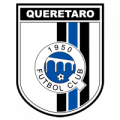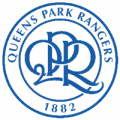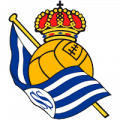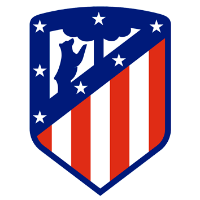
Club Atlético de Madrid
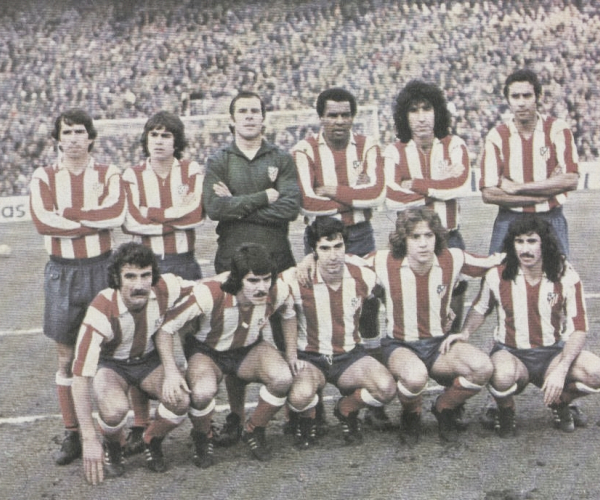
1903 Madrid
Atlético de Madrid is considered one of the historic teams in the Spanish league since its foundation in 1903. With eleven league titles in its history -the last one won in the 20/21 season- it is the third Spanish team with the most titles, behind FC Barcelona with twenty-six and ahead of Athletic Club de Bilbao with eight. Despite these figures, Atlético de Madrid has played 85 seasons in the First Division -unlike Real Madrid, FC Barcelona and Athletic Club, which have played 91-, as in 1930 the Madrid club was the first team to be rele gated from the First Division in the history of the Spanish league.In 1930, the Madrid club was the first team in the history of the Spanish league to be relegated and it would take four seasons to return to the Spanish top flight, which, added to the two campaigns in the Second Division at the beginning of the 2000s, makes six seasons that Atleti has not competed in the national top flight.
Biscayan origins
The exciting history of Atlético de Madrid began on April 26, 1903, when a group of students from Biscay from the School of Mining Engineers, who were members of Athletic Club de Bilbao, joined with a group of people from Madrid to create a subsidiary of the Basque club in Madrid, giving rise to Athletic Club de Madrid.
Although at first the relations between both clubs were good, the Madrilenians asked to be more independent, which they achieved in 1912 thanks to Julián Reute, president at that time, and whose playing field was located in O'Donnell Street.
It was in 1923, on May 13, when they inaugurated the Metropolitano stadium, which they shared with other teams of the capital, such as Gimnástica, Unión Sporting or Racing Club de Madrid. With the arrival of the Civil War it was destroyed, so they had to play their home games for several years in the Chamartín Stadium and in the Vallecas Stadium, where they were proclaimed champions of their first leagues. Before this, in 1939, an agreement was signed between Athletic Club de Madrid and Club Aviación Nacional, so that the name of the club was changed to Atlético de Madrid Aviación.
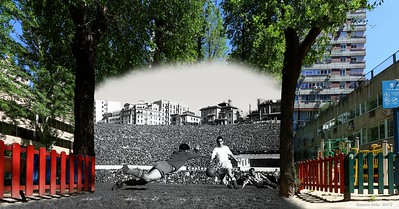
From that moment on, the Atlético team, was nicknamed "colchonero" due to the fact that at that time the lining of the post-war mattresses were the same color as the jersey. The first time the club won the league championship title was on April 28, 1940, at which time the coach was Ricardo Zamora.
The first years in the league
Los Rojiblancos were one of the debutant teams in the league in 1929 thanks to a runner-up finish in the old Spanish Championship, currently known as the Copa del Rey, along with Real Madrid, Athletic Club, Arenas de Guecho, Real Sociedad, FC Barcelona, Real Unión, Español and Europa. Atletico de Madrid did not last long in the First Division, as in 1930 they were relegated to the Spanish Second Division, being the first team to be relegated in the history of the competition.

During its first year in the silver competition , its disappearance was feared, as a social, economic and sporting crisis attacked the Madrid club, but with the change of president and a rapprochement among the club's members, the team's revival was achieved. Atleti spent four seasons in the Second Division, returning to the Spanish league in 1934 after the approval of a new rule that allowed the promotion of the runner-up as well as the champion -a position occupied by Atletico de Madrid-. It should be mentioned that only one year later the Madrid club should have been relegated again, but due to the Spanish Civil War the competition was paralyzed and the relegation never took place.
With the end of the war conflict, Atlético de Madrid would return to compete in the highest category of the Spanish league, since after a series of events, the Madrid club would win Real Oviedo 's place in a match against Osasuna. It is important to remember that a month before this match, the union between Athletic Club de Madrid and Club Aviación Nacional took place, thus putting an end to the economic crisis that the Madrid team was going through and adding great players from Aviación to its roster that would turn Atlético into a strong and competitive team.

The 40's and the first league title
Just one year after the union and the resumption of the Spanish competition, Atlético de Madrid would lift its first league title in 1940. tulo liguero in 1940, which added to the -still unofficial- Supercopa de España won a few months later, would achieve the first double in the history of the colchonero club. That season they were forced to move to the Estadio de Vallecas where they achieved an unbeaten home record of nineteen matches that no one has managed to come close to, except the rojiblancos themselves in 2018 with the Metropolitano. A year later, Atleti would revalidate the league title along with the Pichichi achieved by Pruden with 32 goals and the Zamora achieved by Fernando Tabales. The following seasons were completed without anything remarkable, beyond the fact that in 1947 the colchonero club was renamed Club Atlético de Madrid.
In the 49/50 season, Helenio Herrera arrived on the bench , a coach who would take Atlético de Madrid to a very high level with a style of play based on the novel catenaccio, achieving their third league title after a record second round -they started eleventh and finished first-. The following year, Atleti would once again become league champions, in addition to leading in the capital, as during that season they beat Los Blancos 3-6 and 4-0 and doubled the league titles of their neighbors.
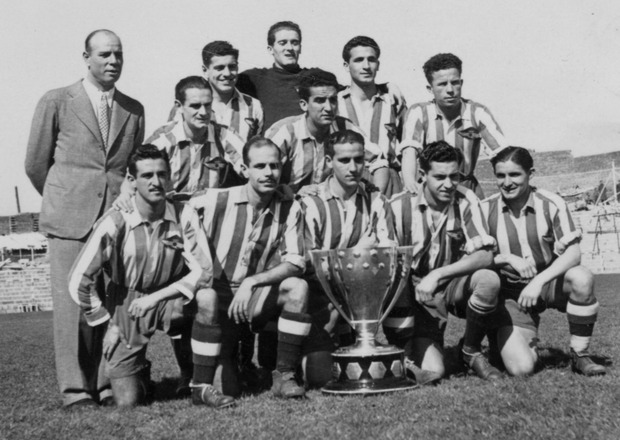
The 50's, 60's and 70's bathed in red and white
A few years later, the red and white stage known as "the infernal wing" was inaugurated with a squad led by Collar and Peiró, to which historical players such as Adelardo, Mendoça or "Pechuga" San Román were added. This generation of great players achieved a runner-up finish in the league in 57/58, which led them to compete in the European Cup for the first time in the history of the red and white team. Surprisingly, during these years they did not win any league titles, but they did win European and other national titles.
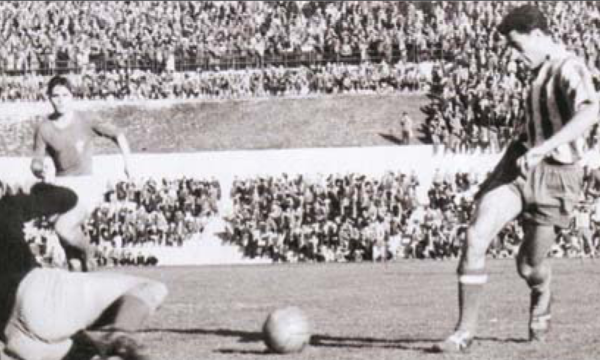
After almost fifteen years, Atlético would lift its fifth league title with Luis Aragonés at the head of the team, in addition, in the following season, the Vicente Calderón Stadium, home of many generations of red and white players, would finally be inaugurated. Atlético de Madrid's next league title was not long in coming, as in 69/70 the newly baptized Indians would raise the cup to the skies of Madrid once again. Just as "the infernal wing" left great players for the history of Atleti, the 70's of the colchoneros left many great memories in the memories of the fans.the memories of the fans with players such as Capón, Rodri, Ufarte, Garáte or Luis Aragonés -the latter two shared the top scorer with sixteen goals each-.
The seventh league would come in 72/73 with a team led by Luis Aragonés on the field and Max Merkel on the bench. This league was Atlético de Madrid 's ticket to the '74 European Cup, which, as many Colchoneros will remember, they lost in a play-off against Bayern, after conceding a goal 30 seconds before the final whistle. After this tragic final, Luis Aragonés would take the helm of Atlético, becoming the coach of the red and white team.

"Paseo de los melancólicos, Manzanares.... How much I love you".
In 1966 the "Manzanares Stadium" was inaugurated, which was renamed "Vicente Calderón Stadium in July 1971, in honor of the name of the then president of the club. (You can listen to Sabina's song "Motivos de un sentimiento" here, on Joaquín Sabina's official channel, while you continue remembering the best moments of the club's history: https://www.youtube.com/watch?v=ziuFfF9sYIw)

In 1974, Atlético de Madrid faced Bayer Munich in the final of the European Champions Cup. During the match, during the extra time, the much loved by all soccer lovers, Luis Aragonés scored a fantastic goal, but it was not enough to prevent the second leg, where they lost.
The 80's are remembered in the club for being the years in which Luis Aragonés was coach of Atlético de Madrid and in which, at the end of the decade, in 1987, Jesús Gil triumphed in the elections and became the new president of the club.
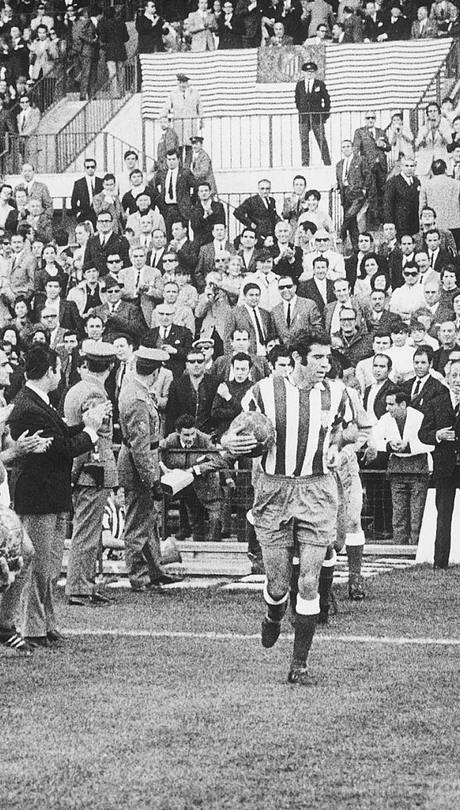
The decade of the 90s was marked by several triumphs and among them stands out the eighth Copa del Rey defeating, once again, Real Madrid at home, at the Santiago Bernabéu by 2-0 in 1992, with Luis Aragonés at the head of the colchoneros.
The presidency of Jesús Gil
With "the wise man from Hortaleza" in the dugout, it didn 't take long to win a league title, only two years were needed to conquer Atlético de Madrid's eighth league. Curiously, this league was held at the Santiago Bernabéu, as the draw achieved at the neighbors' ground was enough for Atleti to be proclaimed champions. It was not until the arrival of Jesús Gil to the presidency of Atlético in 1987 that Luis Aragonés would leave the red and white club's dugouts, but Gil would not take long to retract and after a few years of bad results he would once again count on the services of Luis to lead the team.
After years of comings and goings, marked mainly by the social and economic crises caused by the new S.A.D. denomination and the bad management of Jesús Gil, a joy for the red and white fans would arrive. During the 95/96 season, the first official double in the history of Atlético de Madrid would be achieved, a feat that would be forever marked in the red and white memories and that would turn personalities such as Kiko, Simeone, Pantic or Radomir Antic into legends. That was how Atlético de Madrid would win its ninth league title after some hard years of drought and crisis.
The double of '96
For the first time in the history of the colchonero club, they were champions of La Liga and the Copa del Rey in the same year, being the second to achieve it after Real Madrid, Barcelona and Athletic Club.
The winning goal that gave Los Rojiblancos the Copa del Rey was Pantic's goal against Barcelona. The achievement of the League title meant that they were for the ninth time in their history. It is worth remembering some of the most notable and beloved players from that fantastic season: Caminero, Pantic, Kiko and Simeone, who is currently the club's coach.
To see Caminero talk about that double, you can click on this link https://www.youtube.com/watch?v=_scQEw3xKe8 from the Movistar Plus channel in which the former Colchonero player himself recalls those old times.
The descent into hell and the comeback
With the double in their trophy cabinets came one of the darkest times of the red and white club: Gil in custody, economic crisis in the club, players' strike, bad results... As expected, Atlético de Madrid would be relegated to the Second Division in 2000 for the second time in its history. It should be noted that during the first year in the silver division, the number of members increased by 68%, which says a lot about what it means to be Atlético de Madrid."Two little years in hell" were more than enough for a team like Atlético de Madrid. A generation of historic players, led by Luis Aragonés, were the ones who brought Atleti back to the Spanish First Division, but if anyone stood out above all of them, it was Fernando Torres, the very young canterano who shed some light among so much darkness. In 2002, the colchoneros returned to the league with the Second Division title under their arms.
A draw against Oviedo in May 2000 sentenced the club to relegation to the second division. But it didn't take long for the colchoneros to bounce back, it only took two seasons for Atlético de Madrid to return to compete at the highest level in the First Division in 2002, with Luis Aragonés as coach and Fernando Torres as the new red and white star.That same year, Enrique Cerezo took over the presidency of the club, which he continues to lead to this day.
A few years later, in 2007, Diego Forlán stood out as the team's top scorer, sharing the dressing room with other greats such as Luis García and Simao. The latter was the most expensive signing in the club's history, up to that moment, because it cost them 20 million euros along with the loan of two other players.
In the 2009/2010 season, Atlético de Madrid faced Fulham FC, an English team against whom the Europa League final was played at the Hamburg Arena. With a 2 - 1 result in favor of the colchoneros, they were victorious.
The following years since the promotion would pass without any glory for the red and white team. Atlético de Madrid had no problems to keep the category, however, they did not achieve their goal of returning to European competitions, so the years would pass, as well as the players and coaches. It was not until 07/08 that Atleti would return to play in a European competition -beyond the old Intertoto, which they would even end up winning- after achieving fourth place in the league with Agüero and Forlán at the helm. Their passage through the Champions League was brief, as they lost in the round of 16 against Porto, but they repeated their qualification in the league and returned to the competition the following year.
And so came 2010, which to this day may be one of the most successful periods in the history of the red and white club. Atleti, with Quique Sanchez Flores as coach, would win the Europa League, a few months later they would add the European Super Cup. As always, the quarrels against the board would be to blame for the poor results on the field, as Quique was fired and with him players like Agüero, Forlán or De Gea left, which caused the club's directors to have to spend their last bullet in the chamber: Diego Pablo Simeone.
The cholista period
In December 2011, Diego Pablo Simeone, El Cholo, began coaching Atlético de Madrid, the team that was his home when he was a player. With his philosophy of "game by game" and "never stop believing", he has taken the red and white team to the top of the competitions.
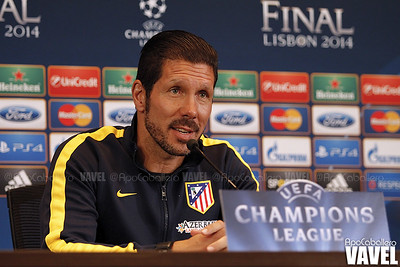
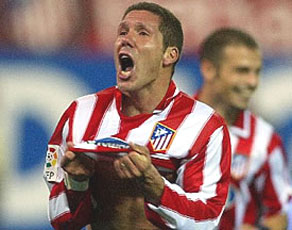
The start of the 2012 season could not have been better, with a 4 - 1 result against Chelsea, Atlético de Madrid became for the second time as European Super Champion. A victory to remember was the match against the eternal rival, Real Madrid, in the final on May 17, 2013. In that match Atlético de Madrid beat them 1 - 2 at the Santiago Bernabéu, which meant that the red-and-whites became champions of the Copa del Rey 17 years later.
Cholismo as a way of life
In December 2011, Simeone would be presented as Atletico Madrid's new coach, but no one expected this Argentine ex-player to change the club's history as he did. Just half a season was enough for him to lift the club's second Europa League, as well as reaching fifth place in the league -before his arrival, Atleti was eleventh. They were also proclaimed European super champions with Falcao' s magical match against Chelsea. In 12/13, Atleti would finish third in the league and beat Real Madrid in the final of the Copa del Rey at the Santiago Bernabeu, ending more than fourteen years of white domination. It was known that this Atlético de Madrid under Simeone was something different, but the reality is that the "Cholismo" era had just begun.
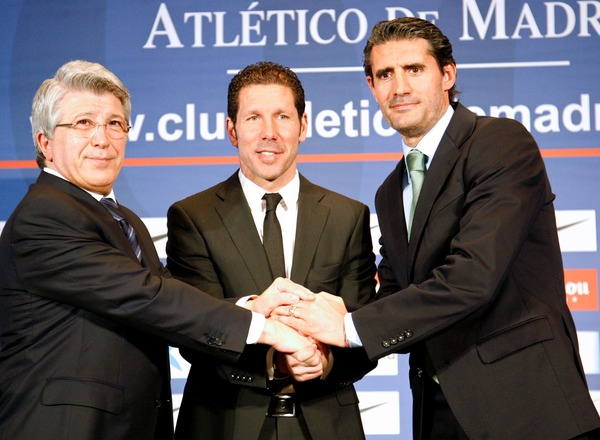
The bittersweet 2013/14 season
Atlético de Madrid won the League title a few days before playing the final against Real Madrid in Lisbon. On this occasion, after Atlético de Madrid had been winning the whole match thanks to a goal by Godín, Real Madrid 's Sergio Ramos tied the match in the 93rd minute, which meant an extra time in which Los Blancos conceded three more goals defeating Atlético.
This sadness would be short-lived as, at the start of the following season, Atlético de Madrid was champion of the Supercopa de España beating with a 2-1 aggregate score. In the 2015/16 season, Cholo managed to take his team back to the Champions League final, which was played in San Siro, Italy, against Real Madrid once again. The bad memories came back and Los Atléticos suffered until the end, this time they had to hold on until the penalty round, where they lost 5 - 4 on aggregate.Real Madrid
The 2013/2014 season was probably one of the most beautiful seasons of the club, the rojiblancos would once again conquer a league title ending years of Merengue and Culé supremacy: Simeone and his players had defeated two giants such as Cristiano' s Real Madrid and Messi's Barça . We suffered, we celebrated, but the most important thing was that we enjoyed the journey. On May 17, 2014, Godín would fly through the sky of Barcelona to score the goal that gave Atlético de Madrid a draw against Barcelona, proclaiming the colchoneros as league champions eighteen years later.In addition, the red and white team would reach the Champions League final for the second time , which was already something historic for the club, but they would lose in stoppage time -once again- against Real Madrid.

That season would be hard to beat, but there were still many joys to celebrate with Simeone as Atlético de Madrid's coach. Supercopa de España in 2014, a third Champions League final in 2016, Europa League in 2018, Supercopa de Europa in 2018 and LaLiga in 2021, in addition to achieving for more than ten consecutive seasons the qualification for the Champions League -alternating between third, second or even first place in the league-.
The 2021 league will be remembered by many atléticos as the strangest in history, because during that season a pandemic struck the planet, leaving the stadiums empty, a storm paralyzed the country - unless you had an ATLiga de 2021 -, and a storm paralyzed the country - unless you had an ATLiga de 2021.unless you had a FIAT Panda from the 80s-, Luis Suárez became a player for Atlético de Madrid, a lead of more than ten points over second in December that ended with the red-and-whites suffering against Valladolid in the last round. .. A league in true Atletico Madrid style.

Since its creation, Atlético de Madrid has played 85 seasons in the First Division -only behind Valencia with 87 and Real Madrid, Barça and Athletic with 91- in which it has won eleven championships, ten runner-ups and eighteen third places. In total, it has played 2804 matches in the highest category, obtaining 3824 points in 1351 victories, 650 draws and 803 defeats. Thanks to these data, Atlético de Madrid is the third historic team in the Spanish league, behind FC Barcelona and ahead of Valencia CF.
Farewell and welcome of stadiums
The much-loved Vicente Calderón Stadium enjoyed its last season in 2016/17. The red-and-white tides on the banks of the Manzanares will never be seen again. This season, the red-and-whites finished third in La Liga and eliminated from the Copa del Rey and the Champions League. However, the Atlético fans stayed at the stadium cheering on their players after the elimination, shouting at the top of their lungs the slogan: "they can't understand".
The Wanda Metropolitano Stadium became the new home of the Atlético fans the following year, where exciting moments have been experienced, such as the farewells to great players like Fernando Torres or Gabi. In addition, in recent seasons the club has made the most expensive signing in its history, Joao Felix, for the value of 127 million euros, thus becoming the third most expensive signing in the history of soccer and the first for Atletico Madrid.
Disagreements over the change of the club's crest have been the protagonist of the last few years, and there are still many who do not like it, however, they all maintain their passion for their team of their soul.




